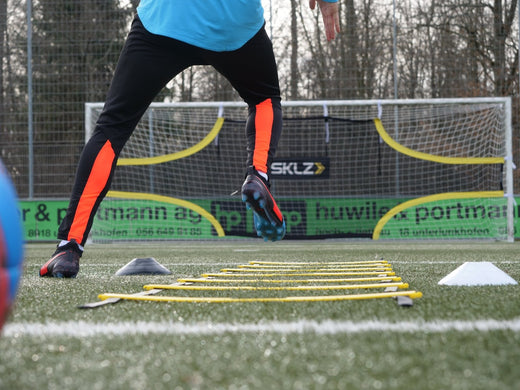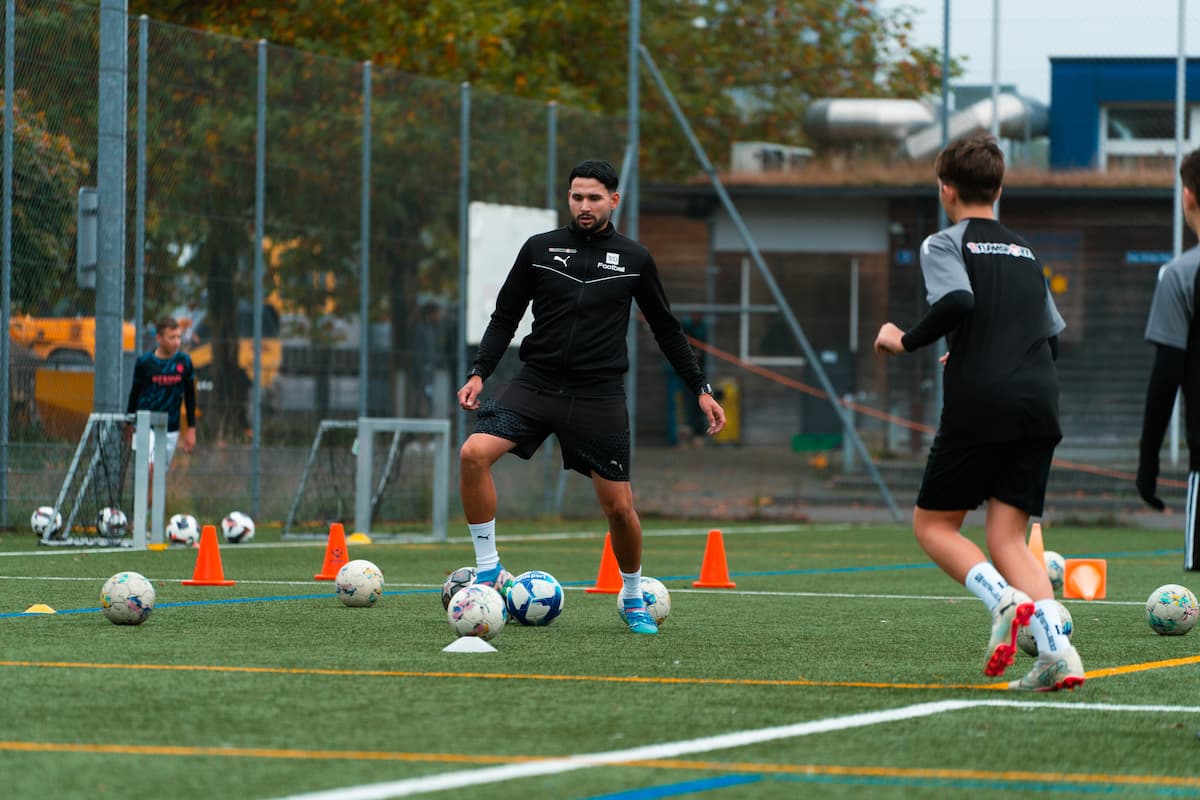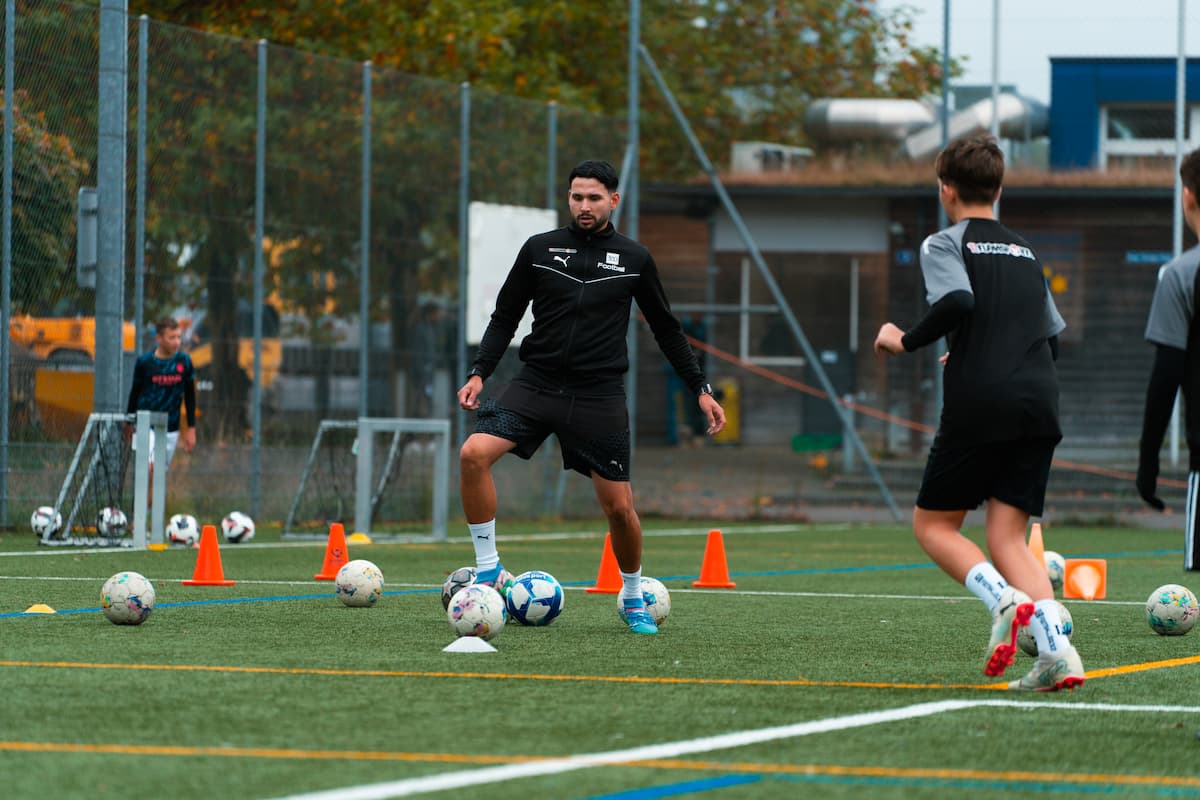Do you want to be able to sprint faster and finally be that decisive step ahead of your opponent? Many top players are characterized by their speed, giving them a significant advantage. That's precisely why it's important for you to work specifically on your speed as a footballer.
Overview:
- Importance of speed training for footballers
- Football-specific speed
- Physical principles
- strength training
-
Specific training on the pitch
- The diet
- Test results of a U13 team
- How effectively can I improve?
- How can you accurately measure your speed?
Importance of speed training for footballers
If you "only" play soccer on the side and don't have much time for additional training, you should prioritize exercises with the ball. However, speed training is extremely important for soccer players who have ambitious goals and need to hone all aspects to achieve them. Therefore, training speed is essential to reaching your maximum potential as a soccer player. Great players like Bale and Mbappé impressively demonstrate how their speed can even decide games.
Football-specific speed
When we talk about speed training, you probably imagine a normal straight sprint. However, football involves a lot of abrupt changes of direction, stop-and-go movements, and, above all, 1-10m sprints. You should approach your training accordingly and incorporate various elements (more on that later).
Physical principles
I've prepared a very short theoretical block for you so that you understand the necessary background knowledge for building speed training: Muscles are made up of different types of muscle fibers. A distinction is made between slow-twitch and fast-twitch muscle fibers (Fig. 1). The latter are crucial for speed and are largely innate. These fibers are activated during high-intensity exercise such as sprinting or strength training with a barbell. However, there is a third type of muscle fiber, the intermediate ones, which are highly adaptable and, with the right speed training, can ensure that you effectively become faster. This explains why intensive exercise with sprints and strength training is necessary for speed training. We'll go into this in more detail in the next section.

Figure 1: Slow twitch muscle fibers on the left, fast twitch muscle fibers on the right
strength training
Strength training is an important component of speed training. Effective speed training includes not only sprints but also specific strength training. Speed and explosive power are particularly important for sprints. You can train these very well through targeted strength exercises for the torso and leg areas. Well-trained muscles are the foundation for all sprints. However, if you want to optimize your speed training plan, you should also integrate explosive (performing the exercise with the greatest possible force and speed) and reactive (swinging movement and then braking with the target muscles and immediately accelerating again in the other direction) strength training. As described above, the fast-twitch muscle fibers are responsible for enabling us to perform fast, explosive movements, such as when starting. If you now do almost exclusively endurance exercises in a sport like soccer, there is a risk that too many intermediate fibers will convert into slow-twitch fibers, thus reducing your speed. To counteract this conversion, appropriate strength training is necessary. On the one hand, classic strength training with basic exercises is important for optimizing the interaction of muscle fibers and being able to generate more power in the shortest possible time. Important basic exercises for building the necessary power include:
- Deadlifts
- Lunges
- Squats
For all of these exercises, you should work in the low repetition range to train maximum strength (1-5 repetitions) and allow sufficient rest (approximately 2-4 minutes) between sets. You can perform approximately 3-6 sets per exercise. Start with a little less, and then increase with experience. To achieve sustainable progress, you should ensure steady progression (increasing weight, number of sets, and number of repetitions).
A clean execution is also a prerequisite to avoid injuries to the musculoskeletal system.
On the other hand, explosive strength training specifically trains the fast-twitch fibers and ensures their maintenance. A combination of basic exercises and explosive strength training is recommended.
You can find some explosive strength exercises for on the pitch in the following video:
By the way, you can subscribe to our YouTube channel HERE to always be up to date.
Specific sprint training on the pitch
A good warm-up is especially important for speed training; without it, the risk of injury is extremely high. During the explosive accelerations of speed training, you can easily pull a muscle if your muscles aren't already warmed up. Therefore, a good warm-up is essential at the beginning of every speed training session.
Since speed cannot be improved in a fatigued state, sufficiently long rest periods between exercises are extremely important. The nervous system must have enough time to regain full readiness, as must the muscle fibers to fully replenish their ATP and creatine phosphate stores.
As a rule of thumb:
- For every 10 meters sprint distance, take at least 30 seconds of rest
It's also important to internalize the movement sequences of the exercises thoroughly at first and only then perform them under time pressure. Quality over quantity! Once this is met, it's crucial that you complete the exercises at maximum speed. Competing with a training partner is a good way to do this. This way, you can push each other to achieve peak performance. If you don't have a training partner, you can also race against the clock and challenge your own personal best. This makes training more fun and increases motivation.
To address the football-specific requirements, exercises are recommended with:
-
Running ladder (primarily helps with coordination and not maximum speed)
- Change of direction
- Stop-and-go
- Explosive elements
-
Resistance (The exercise shown in the video was performed with a sprint distance that was too short)
The following video presents exactly 5 exercises in this area:
To further focus on changes of direction, the following exercises are recommended:
The diet
In strength and sprint training, in addition to optimizing the interaction of muscle fibers, muscle growth can also play an important role. The following nutritional considerations must be taken into account: To build muscle for sprinting, you should eat more than you burn (a calorie surplus of approximately 300 calories is sufficient) so that your body can use the excess energy to build the necessary muscle. If this isn't the case, you're wasting potential.
If you are looking for a nutritionist, we can recommend Thomas !
Additionally, it may be beneficial to take creatine as a dietary supplement. Supplementing with Creatine360 has a positive effect on explosive strength performance during short, maximal effort, such as a sprint during a game.
The caffeine-containing product Pregame360 can also help sharpen your focus. Especially if you're feeling a bit tired before training, a caffeine-containing product tailored to football players is a good option.
If you want to learn all the basics about football nutrition, watch the following video or take a look at the 360Football Nutrition Guide :
Test results of a U13 team
Over a period of six weeks, we conducted 10 training sessions, each lasting 20-30 minutes (a total of 4.2 hours of training time). For simplicity, we focused on a few ladder exercises, various sprint variations, and a short core strength workout. We then measured the 10m and 30m dash times of nine players before and after the training program.

On average, the nine players improved their 10m sprint time by 0.04 seconds or 1.89%.

On average, the nine players improved their 30m sprint time by 0.14 seconds or 2.96%.
How effectively can I improve?
As we already know, your speed potential is largely determined by the genetic distribution of muscle fiber types. Furthermore (in order to make a clear statement, significantly more test subjects would have to be tested) our test also seems to have a tendency that only a low percentage improvement is possible in 10 weeks and thus even with specific training no major effect can be achieved compared to, for example, endurance. However, if you compare the training effort with the result, a noticeable effect was achieved in a total of ONLY 4.2 hours of training time. What can we learn from this? Speed is still dominated by genetic conditions. But with relatively little effort, you can perhaps scrape out the crucial 2-3 percent out of yourself and thus be faster to the ball than your opponent.
How can you accurately measure your speed?
When it comes to precise speed measurement, one usually thinks of expensive equipment. Fortunately, there are now affordable and practical speed measuring devices that measure to the nearest hundredth of a second. Our recommendation is the Jawku measuring device, which we use almost daily with our players. The device resembles a watch and works in conjunction with the Jawku Speed app.
Since we fully support this product ourselves, and speed measurement can be very important for every footballer and coach, we've organized a 15% discount code for Jawku , which is "360football." You can use this code when purchasing a Jawku measuring device .
#LevelUpYourGame
-
Book a personal soccer training session and improve more than just your speed.
-
Take your nutrition to the next level. With recovery and nutrition tips and our supplements for footballers.
-
You can find the best football grip socks at Tapedesign.
Sources:
Fig1: “Types of muscle fasting” http://physiologie.cc/XV.2.htm
Speed“ http://www.sportunterricht.ch/Theorie/schnelligkeit.php Sportunterricht.ch.
Mastersport” http://www.trainingsworld.com/training/schnelligkeit-und-kraft-fuer-aeltere-sportler-1278236.html Trainingsworld.
Dennis Sandig. "Speed Training" http://www.trainingsworld.com/training/schnelligkeitstraining-sti109207/prinzipien-schnelligkeitstrainings-2332809.html Trainingsworld.
Mark Maslow. “Muscle fiber types” http://www.marathonfitness.de/muscle-fibre-types-table-determining/ MarathonFitness.
Denis Sandig. "Training Tips" http://www.trainingsworld.com/training/schnelligkeitstraining-sti109207/grundlagentraining-verbessern-ihre-schnelligkeit-komplex-2789577.html. Trainingsworld.
"Strength and Speed in Football" https://sport.lu.ch/-/media/Sport/Dokumente/J_u_S/th_3_kraft_und_schnelligkeit_im_fussball_gafx.pdf?la=de-CH Swiss Football Association p. 5
"Recovery against overtraining" http://www.trainingsworld.com/training/ausdauertraining-sti60503/erholung-gegen-uebertraining-1273611.html
"Fundamentals of Speed Training" http://www.mobilesport.ch/aktuell/schnelligkeit-grundlagen-und-techniken-des-schnelligkeitstrainings/
"Training with the Coordination Ladder" http://www.functional-training-magazin.de/speed-und-koordinationstraining-mit-der-koordinationsleiter/
"Can you train speed?" (Böhler, T. 2021) https://www.online-trainer-lizenz.de/blog/schnelligkeitstraining/
"Strength and Speed in Football" https://sport.lu.ch/-/media/Sport/Dokumente/J_u_S/th_3_kraft_und_schnelligkeit_im_fussball_gafx.pdf?la=de-CH Swiss Football Association, p. 8,9 (accessed September 16, 2015)
“Aerobic-Anaerobic Threshold” http://www.runnersworld.de/training/aerob-anaerobe-schwelle.261018.htm


